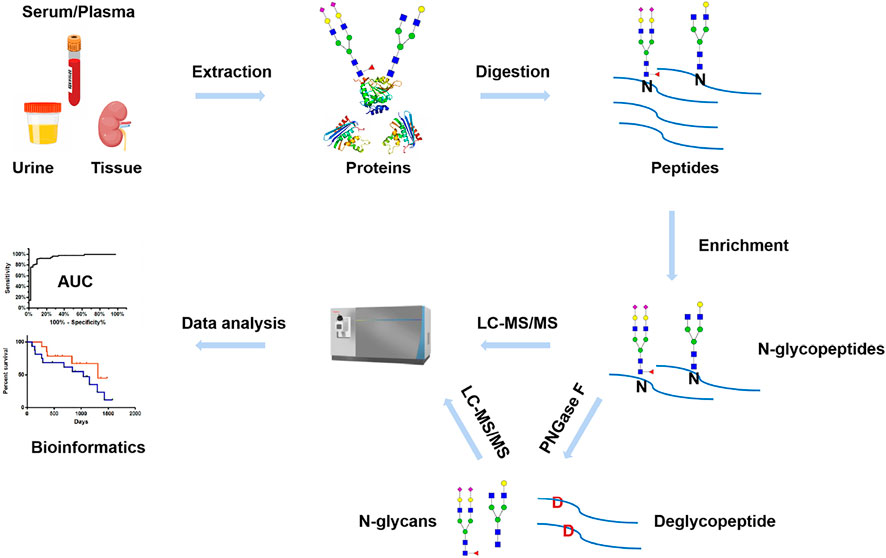Glycoprotein Label-free Quantitative Analysis Service
Glycoproteins are essential regulators of cellular communication, receptor interaction, immune modulation, and disease progression. Their structural complexity and functional diversity make them prominent targets in both proteomics research and biopharmaceutical development. Unlike label-based quantification methods such as TMT or SILAC, label-free quantification (LFQ) enables relative quantification without the need for chemical labeling. This approach simplifies the workflow, broadens applicability, and is particularly well suited for large-scale studies involving complex biological samples.
MtoZ Biolabs offers high-sensitivity Glycoprotein Label-free Quantitative Analysis Service powered by advanced mass spectrometry platforms and deep expertise in glycoproteomics. Our service enables researchers to rapidly assess glycoprotein expression patterns across multiple conditions, supporting functional studies, disease mechanism research, and the identification of potential therapeutic targets.
Analysis Workflow
Our Glycoprotein Label-free Quantitative Analysis Service employs an optimized and reproducible LFQ-based pipeline, encompassing the following key steps:
1. Sample Preparation
Compatible with various biological matrices including serum, plasma, urine, and tissues. Total proteins are extracted following sample lysis to provide a comprehensive proteome for downstream analysis.
2. Enzymatic Digestion
Proteins are subjected to reduction and alkylation, followed by trypsin digestion to generate peptides suitable for mass spectrometry.
3. Glycopeptide Enrichment
Glycopeptides are selectively enriched using lectins or hydrophilic interaction chromatography (HILIC) materials to improve the detection of low-abundance species.
4. Optional Deglycosylation
Depending on the research objective, users may choose to perform PNGase F digestion for accurate glycosylation site identification, or proceed directly with intact glycopeptide analysis to retain glycan structural information.
5. LC-MS/MS Analysis
Label-free quantification is conducted using high-resolution LC-MS/MS systems. The platform captures retention time, ion intensity, and peptide sequence information for subsequent quantification.
6. Data Analysis and Quantification
Specialized software tools are used to compare multiple sample groups. Quantification is based on retention time, peak area, and mass-to-charge ratios, enabling reliable identification of differentially expressed glycopeptides, clustering, and functional annotation.

Ren, W. et al. Front. Mol. Biosci. 2022.
Figure 1. Glycoprotein Label-free Quantitative Analysis Workflow
Why Choose MtoZ Biolabs?
✔ Advanced Analysis Platform: Employs advanced Orbitrap and nanoLC-MS/MS systems to ensure precise glycopeptide identification, accurate quantification, and reproducible results.
✔ Label-Free Workflow for Maximum Flexibility: Eliminates the need for isotopic or chemical labeling, reducing complexity and allowing analysis of a wide range of sample types, including clinical and preclinical materials.
✔ Optimized Glycopeptide Enrichment: Utilizes lectin-based and HILIC-based enrichment strategies tailored to specific glycoforms, ensuring high selectivity and sensitivity.
✔ Broad Sample Compatibility: Our workflow supports a wide range of biological samples, making it applicable to medical research, biologics development, and agricultural biotechnology.
✔ Multi-omics Integration Enhances Functional Insights: Glycoprotein quantification can be integrated with global proteomics, glycan structural data, and other omics analyses to reveal regulatory networks and biological functions.
Sample Submission Suggestions
The Glycoprotein Label-free Quantitative Analysis Service supports a variety of sample types, including serum, plasma, urine, and tissues. To ensure optimal data quality, we recommend contacting MtoZ Biolabs in advance to receive detailed submission guidelines. Our team will provide personalized advice on sample preparation, storage conditions, and shipping instructions based on your project goals.
What Could be Included in the Report?
Standard deliverables include the following, with optional customization available upon request:
1. Raw LC-MS/MS data files
2. Quantitative peptide tables with expression levels and coefficients of variation
3. Statistical report of differential glycopeptides
4. Enrichment and pathway analysis charts (optional)
5. Experimental workflow summary and quality control documentation
The Glycoprotein Label-free Quantitative Analysis Service provides an efficient and flexible strategy for quantifying glycoproteins across diverse experimental conditions. It is ideally suited for applications such as disease mechanism exploration, biomarker discovery, and drug action studies. MtoZ Biolabs is dedicated to delivering reliable and reproducible glycoproteomics quantification solutions for researchers worldwide. Contact us for expert consultation and customized technical support to advance your understanding of glycosylation in health and disease.
FAQ
Q1: How sensitive is label-free quantification? Is it suitable for low-abundance glycoproteins?
Our Glycoprotein Label-free Quantitative Analysis Service integrates high-resolution mass spectrometry with optimized enrichment strategies to enhance sensitivity. Although label-free methods may offer slightly lower sensitivity than labeled techniques for certain low-abundance targets, careful optimization of sample preparation and data processing ensures robust and reproducible quantification results.
Q2: Can this service identify specific glycosylation sites?
Yes. When requested, we perform deglycosylation in combination with high-resolution MS to accurately localize N- or O-linked glycosylation sites. For studies focused on overall glycoprotein abundance, this step can be omitted to retain intact glycan structures during quantification.
Related Services
Glycoprotein Quantification Service
How to order?







